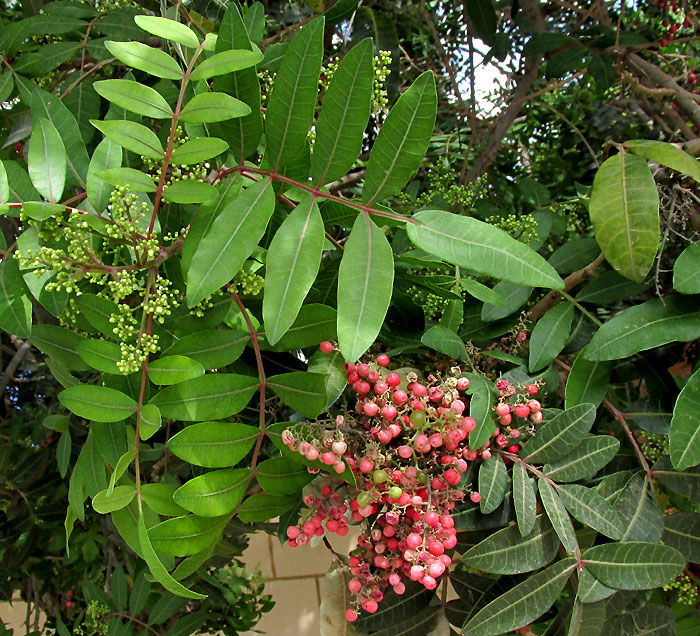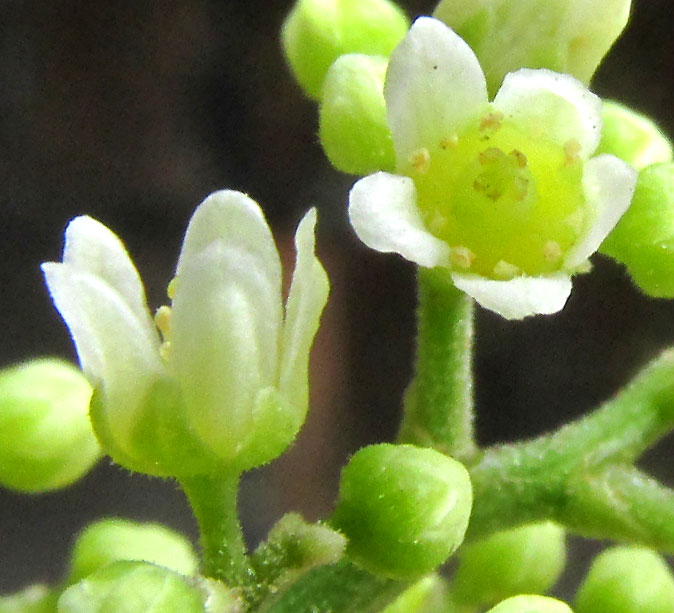Excerpts from Jim Conrad's
Naturalist Newsletter
entry dated May 12, 2022, issued from near Tequisquiapan, elevation about 1,900m (6200 ft), ~N20.57°, ~ W99.89°, Querétaro state, MÉXICO
BRAZILIAN PEPPER TREE #2

The flowers and fruits of a commonly planted street tree in upland central Mexico is shown above. Usually it's called Brazilian Pepper Tree, but there are two closely related but different species known by that name. The above image shows SCHINUS TEREBINTHIFOLIUS. The other is Schinus molle. If you click on that link, you can see that the other species' leaves and flower clusters are much longer and drooping, while our Schinus terebinthifolius leaves are divided into much fewer leaflets, and the flower and fruit clusters don't droop. Below is a close-up of one of this tree's flowers:

Brazilian Pepper Trees usually bear unisexual flowers of only one sex; trees are either male or female, though sometimes bisexual flowers do occur. The above flowers are definitely female, but you can see in the flower at the right several male stamens surround the female green ovary. It's unclear whether that flower is unisexually female, or bisexual.
In upland central Mexico both Brazilian Pepper Trees frequently are planted, though the other species seems to be more popular. In Querétaro state I've seen the other species escaped into the wild, but in this area so far I've not seen either species in the wild. That may be because it's more arid here than in the mountains where at least the other species has escaped.
In certain parts of the world, however, our Schinus terebinthifolius has rampaged into the countryside, replacing large areas of native flora, as on the eastern and western coasts of Australia, Florida and other hot spots in the US, southern Europe, Africa and more. In Florida is against the law to sell or purposefully plant the species.
In 2017, Jiri Patocka and Joyce Diz de Almeida published a study entitled "Brazilian Pepper Tree: Review of pharmacology" in which they tell us that in folk medicine our Schinus terebinthifolius "... has been used as a remedy for ulcers, respiratory problems, wounds, rheumatism, gout, diarrhea, skin ailments and arthritis, as well as to treat tumors and leprosy." They provide numerous references to lab studies in which "The essential oil and leaves have demonstrated in vitro antibacterial activity against numerous bacterial strains."
It's not surprising that Brazilian Pepper Trees contain powerful chemical compounds, for they are members of the Cashew Family, the Anacardiaceae, in which Poison Ivy, Poison Oak and Poison Sumac are found. Chemicals that are toxic or irritant in one dosage or manner of application often prove to be medicinal in another.